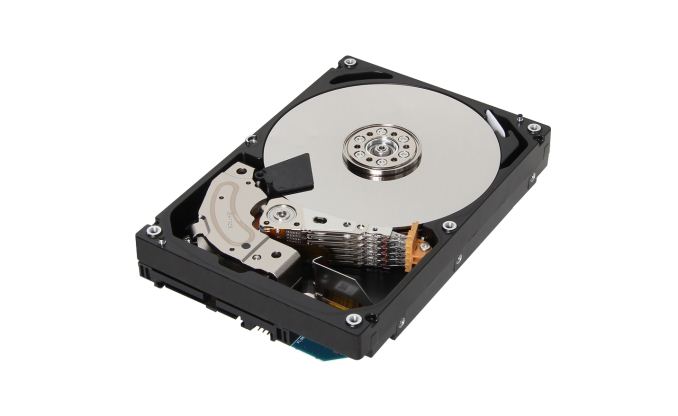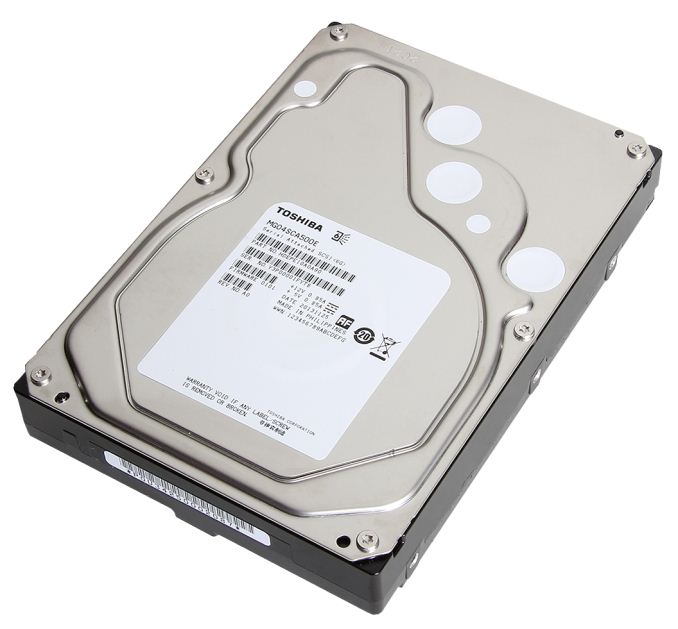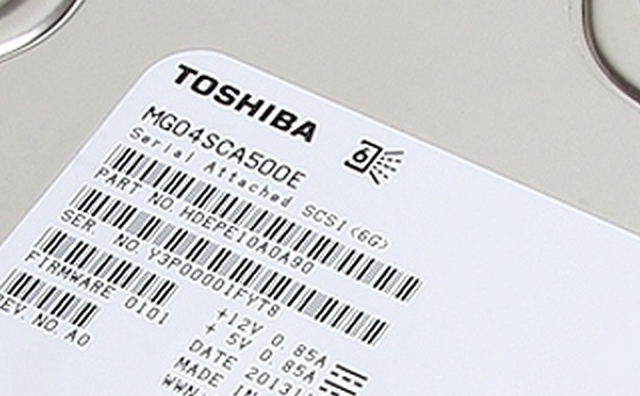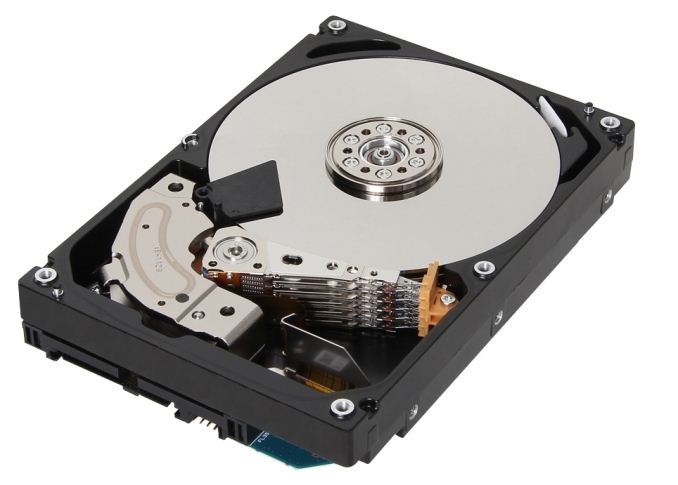5TB 3.5” Enterprise HDD from Toshiba Announced
by Ian Cutress on February 15, 2014 10:25 AM EST
Despite the focus on immediate storage is on the solid-state drive, whenever a large backup is needed then the mechanical hard-disk drive is still reigning supreme, and the demand for data density has never been higher. In the consumer space 4TB drives have been on sale for a while, currently for around $164 in the US or £123 in the UK. These were four platters at 1TB each, or five platters at 800 GB each, using PMR (perpendicular magnetic recording, remember this video?). Toshiba Electronics Europe has just announced the amalgamation of the higher platter density with the higher number of platters, in an enterprise level 5TB 3.5” 7200 RPM drive.
These new drives will fall under the MG04 heading, succeeding the MG03 range. Some of these drives also feature Persistent Write Cache Technology, which Toshiba states improves application performance and data-loss protection. The drives will be equipped with either 6Gb/s SAS (MG04SCA) or 6Gb/s SATA (MG04ACA) interfaces, and can also be supplied with Toshiba’s Sanitize Instant Erase (SIE) functionality.
The SIE drives have models that support either 512e or 4Kn format storage modes for modern performance or legacy applications. The drives are quoted with a 4.17ms average latency time, 8.5-9.5ms read/write seek time and a sustained transfer speed of 205 MiB/s. MTTF is at 1.2m hours, with idle power quoted as 6.2W, with 11.3W during read/write operations. The internal buffer for SATA drives is set at 128 MiB, with SAS drives having 64 MiB.
No information was given about release date and pricing – given the enterprise focus that Toshiba Electronics Europe is giving this product, I would imagine the focus would turn to local Toshiba representatives for individual pricing.
Given that one other company has been quoted as using Shingled Magnetic Recording in their 5TB drives for 2014, after speaking with Kristian we are under the assumption that this is still PMR technology. I must confess that at this point in the HDD cycle we might have 6TB 3.5” drives in the consumer market, but the recent focus on SSD consistency and a combination of overcoming physical limitations via new methods might be causes for the delay. HGST are sampling their 6TB helium filled drives, however that technology is aimed solely at the enterprise market. Should we get a sample in, keep your eyes peeled for a review.













42 Comments
View All Comments
name99 - Saturday, February 15, 2014 - link
I'm not interested in religious wars. I'll just comment on two things.(a) A Mac is NOT a PC, in the sense that a Mac is not a member of the PC commodity. That's precisely my point. Apple HAS avoided becoming a commodity. The PC vendors have tried to avoid that fate, but have been unsuccessful. There WAS a time when PC brands were to some extent differentiated --- Compaq in particular really meant something as brand. But not for the past five years.
The PC vendors, like the HD vendors, are aware of the problem. But they have both waited too long to try to deal with it, and simply don't have the resources for meaningful differentiation. The difference between PC vendors is in what crap they ship pre-installed. The difference between HD vendors is likewise in useless crap they ship on the drive. These are NOT differentiators that persuade a buyer to pay more for a product; unlike the differentiation that Apple has achieved.
(b) You would have to be deluded to claim that the rate of innovation in HDs today is the same as it was.
2007 1st 1TB HD
2009 1st 2TB HD
2010 1st 3TB HD
2011 1st 4TB HD
2012 nothing
2013 nothing
2014 An extremely expensive 6GB HD and a (who knows the price) 5TB HD. (Yeah, yeah, the 6GB was announced in 2013. Let me know when it ships...)
To me this is a dramatic slowing down. We've gone from essentially exponential growth in capacity (doubling in size every two years or so) to sub-linear growth in capacity.
We've seen slow improvements in the 2.5TB form factor over that time. While 3.5 capacity has largely stood still, 2.5TB has grown from about 750GB to 2TB. But 3.5 strikes me as the canary in the coal mine. That's where the research will appear first. Instead all we have is that standing still while 2.5" repurposes 3.5" ideas from a few years ago.
MrSpadge - Sunday, February 16, 2014 - link
There are technical reasons for the slow-down. We're used to rapid progress in HDD technology because there were quite some low-hanging fruit to be had. Look at what they're doing now: shingled recording, helium filling, laser assisted recording or putting more platters into the same form factor than ever before. Any of these is significantly more complex and often expensive (for them to research and produce) than previous HDD technologies. Rest assured they're not using this just for fun - if they could continue business as ussual (but slower) they'd just do so and maximize profits.Flunk - Saturday, February 15, 2014 - link
I think the bigger issue right now is that software companies haven't come up with a compelling reason to need all that storage space. People would buy larger hard drives if they had any need of them.Kevin G - Saturday, February 15, 2014 - link
There are plenty of reasons for larger drives but they tend to be either enterprise scale (virtual machines) or content (HD video).For the majority of consumers, the 1 TB class of hard drives is more than enough for applications, their personal data and local content. Of course there are end user exceptions but scaling to 4 TB drives decreases that niche and then various RAID implementations resolves the rest.
Streaming and cloud storage (which does merit large capacity drives on the backend) has eased the pressure for larger local storage. Stepping down to a 250 GB or 500 GB class SSD is sufficient for most consumers in terms of capacity, not to mention the massive performance benefits.
In short, the consumer demand for more storage simply isn't there except in very specific niches.
cjb110 - Monday, February 17, 2014 - link
I'd agree, larger drives have become less of a requirement as people's storage either moves into the 'cloud', and as things like NAS becomes more prevalent and cheaper. A single 5/6tb drive is a shed load of data on a single point of failure, and shouldn't be shipping on any consumer based device (unless its the aforementioned NAS device).Possibly when 4k content becomes more common, there will be more cases for larger drives for consumers.
flyingpants1 - Tuesday, February 18, 2014 - link
The WD Black2 is alright. It's $250 on Amazon, compared to Crucial 480GB SSD for $260 and 960GB for $450. I think on a laptop you'd usually just get the 480GB SSD and buy a 1TB external.ruzveh - Saturday, February 15, 2014 - link
I want to ask Anandtech and HDD manufacturer one simple question. Why cant internal HDD go beyond the usual size of 3.5" to more inorder to launch 10 to 100TB HDD? I wouldnt mind buying one. Its better then buying 10 pc of 2TB or more HDD. Are you listening?brshoemak - Saturday, February 15, 2014 - link
They can and have before (look up Quantum Bigfoot - the scariest sounding drive ever) but at such a high density level you will most likely run into issues where the heads and arms travel are the limiting factor in terms of accuracy. I think there are some physics involved that make it not viable from a cost/performance standpoint.Kevin G - Saturday, February 15, 2014 - link
I've personally owned 5.25" full heigh hard drives in the past and seen a 8" unit. With the emphasis on mobile technology and increasing density killed off the 5.25" drives in the mid-90's (the shift to 3.5" hard drives started in the late 80's). In the early 2000's the rise of the laptop saw a further shift from 3.5" to 2.5" as focal point for hard drive manufactures. 3.5" has become form factor for external storage, the incredibly shrinking desktop space and enterprise servers who need storage capacity.That of course doesn't prevent a HD manufacturer from bucking the trend and releasing a 5.25" today, other than it being a very niche product. Going back to the mid-90's 5.25" drives, they had several issues. The motors to spin the platters consumed more power and energy efficiency has become a major factor in computing today. Latencies of 5.25" hard drives were typically lower than their 3.5" counter parts (spindle speeds played a factor as a high RPM 5.25" could have a lower latency than a low RPM 3.5" drive). Then there was the noise factor. 5.25" drives were loud, very LOUD. Imagine living in an apartment and you're backing up to data to a coupe of bare 5.25" and you get a knock on the door. Police have been called to answer a noise compliant about a small motor running inside the residence.* I'd have to look at the data sheets but I've been under the impress that 5.25" drives were more susceptible to vibration and had lower reliability rates.
20 years of technological improvements could negate/reduce many of the disadvantages. However, at current 1 TB/3.5" platter densities the raw capacity gains would be roughly 2.4 TB/5.25" platter. Other ideas like increasing the number of platters. An eight platter 5.25" drive would equate to roughly a 19 TB drive. Costs increases wouldn't be linear but under that false assumption such a drive would retail for roughly $1,000 USD. Honestly, I'd be more comfortable running five 4 TB drives in RAID5/RAIDZ than the single hypothetical 19 TB unit.
*Second hand story but having owned some 5.25" units, I find this believable if they were particularly loud, high RPM units.
MrSpadge - Sunday, February 16, 2014 - link
I like this idea, too, but there are quite a few points against this:- at the same rpm (angular velocity) the outer regions of the platters move much faster in a 5.25" drive compared to 3.5" -> vibration and platter flattering become much worse
-> you need to lower rpm and probably areal density (sicne with more flattering the read/write head can't get as close to the platter)
- at larger diameters access times become worse, es the heads have to travel further
- together with lower rpm this makes for a slow drive (just like the Bigfoot was)
- there's no infrastructure for producing such platters any more -> higher prices due to limited volume
- the motor would have to be significantly stronger and idle power consumption would be significantly higher than 3.5" HDDs (power per capacity might not be too bad, though)
- redundancy: if you run more smaller drives it doesn't hurt as much if one of them fails (you could argue that this won't matter of you ned pretty much infinite disk space)
- big super-expensive drives won't sell in the same quantity as the current disks -> economy of scale won't work as well to drive price down